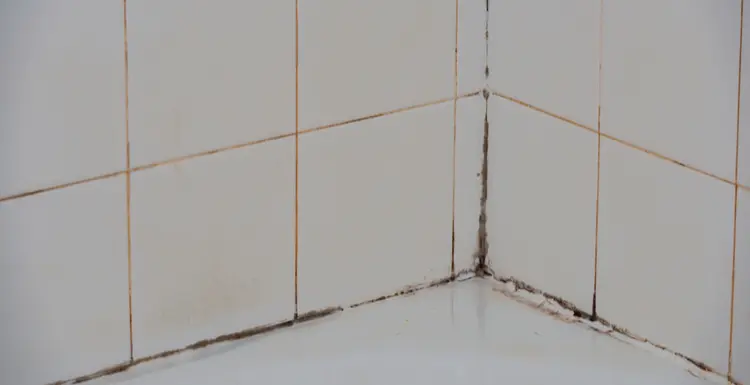Are you wondering why mold might be growing in your shower?
Here, we’ll talk about how to get rid of mold in shower caulk and what you can do to prevent it from coming back.
Read our step-by-step guide below.
Mold in Shower Caulking: A Summary
Mold thrives in a warm, damp environment such as your shower.
Black or pink mold isn’t an uncommon sight when it comes to shower caulking, but fortunately, there are steps that you can take to remove any growth and prevent future flare-ups:
- Protect yourself and your bathroom
- Apply a powerful cleaning solution
- Keep your bathroom clean and dry
Find out more below about how to deal with mold in your shower caulk with the following comprehensive guide.
How to Get Rid of Mold in Shower Caulk
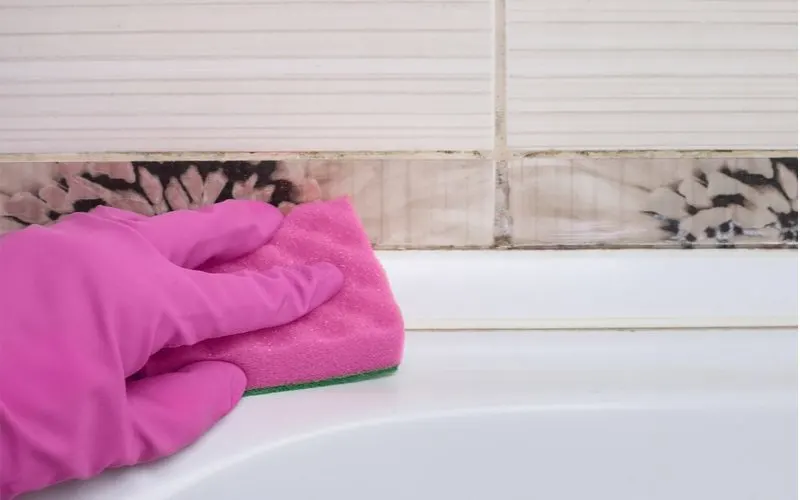
RaspberryStudio/Shutterstock
Most homeowners have had to handle mold in their shower caulk at some point, as it’s a common issue in even the cleanest houses.
Fortunately, it’s easy to remove mold from your shower caulk in just a few easy steps.
Step One: Suit Up
Some molds can pose a health risk if inhaled, leading to coughing, wheezing, and more severe breathing difficulties.
It may also cause a reaction if it gets in the eyes or makes contact with skin. You should always wear protective gear when handling mold to keep yourself safe.
You should wear long pants and sleeves to protect your arms and legs, as well as goggles or safety glasses for eye protection.
Disposable gloves or easy-to-clean rubber gloves should also cover your hands. Finally, you should always protect your mouth and nose with a proper mask such as a NIOSH-approved N-95 filtering facepiece respirator.
Step Two: Prepare the Area
Even if you’re wearing all of the proper protective gear, you still don’t want mold spores free-floating in your bathroom as you clean.
They could settle in other areas and begin to grow, or they could make their way into the rest of the house and irritate other inhabitants.
Always make sure that the area in which you’re working is well-ventilated. Open any nearby windows that you can and keep the bathroom door propped open to promote healthy airflow. If you have a ventilation system installed, make sure it’s turned on as you work.
You may even want to set up some fans to help encourage mold spores to leave the room.
Ventilation not only protects you from any aerosolized mold but also from cleaning fumes stemming from chemical products containing ammonia, bleach, or hydrogen peroxide.
These compounds create fumes that can burn and potentially damage respiratory tissue, mucus membranes, and even skin in concentrated doses.
Step Three: Apply a Cleaning Solution
Once you’re prepared and ready, you can start cleaning mold from your shower caulk.
This step may require a bit of elbow grease, especially for more stubborn mold varieties such as black mold.
There are a variety of products that will effectively kill both growing mold and new spores:
- Ammonia
- Bleach
- Hydrogen Peroxide
- Vinegar
- Baking Soda
- Borax
You should spray solutions of ammonia, hydrogen peroxide, and vinegar on moldy areas and allow them to sit for the best results.
You can also scrub the solution using a sponge or cotton balls when using bleach. Baking soda and borax slurries work best when applied with a brush or spare toothbrush.
Step Four: Replace Caulk If Necessary
If mold is growing behind your shower caulk, you may need to remove and replace it.
Replacing caulk can also help stop recurring or persistent mold infestations in the bathroom. With the right tools on hand, it’s fairly easy to replace caulk by yourself.
First, you should soften the existing caulk using a specialized removal gel. Apply the gel as per the instructions and allow it to sit. Once the caulk is soft enough, use a utility knife to scrape it away from the tiles.
Thoroughly clean the area before applying a new layer of caulk to your shower. Using a caulking gun and waterproof, bathroom-friendly caulk, apply the fresh caulk and allow it to dry as per the instructions.
Avoid using your shower until the caulk has been set completely.
Things to Consider
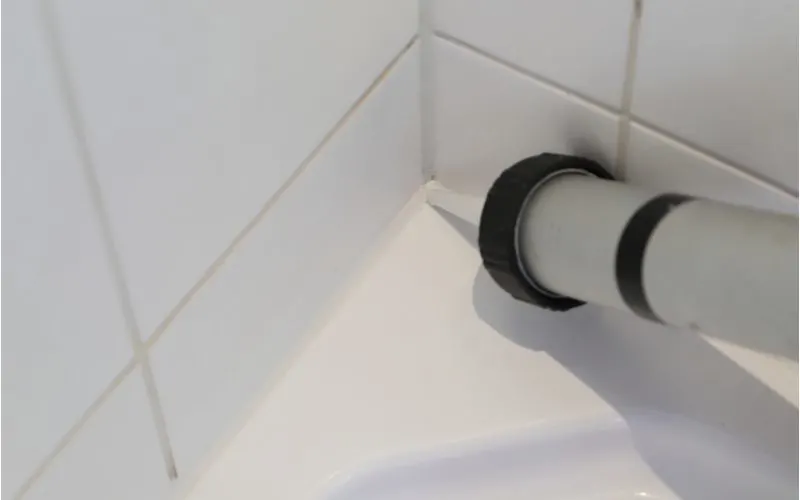
Mahc/Shutterstock
When dealing with mold in your shower caulk, there are some important safety considerations to keep in mind:
- Some molds are toxic, so always wear protection when dealing with a new infestation.
- It’s best to nip mold problems in the bud, as growth can quickly spread behind caulking and shower tiles.
- Silicone caulking is more waterproof and flexible than other styles, making it a mold-resistant choice.
- Always keep your bathroom well-ventilated with a fan or open window to prevent mold growth, especially after a shower.
- If you see mold in shower caulking, there’s a chance more is growing in less visible areas, such as behind cabinets or under the sink, and needs removal.
Frequently Asked Questions
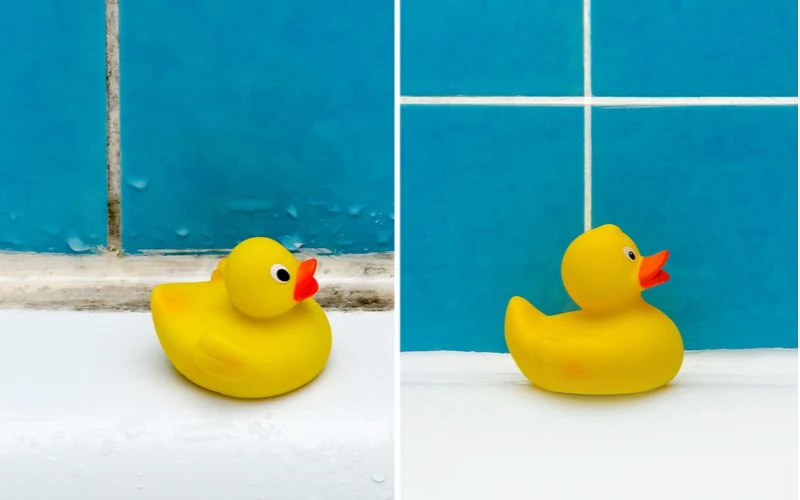
Nadisja/Shutterstock
If you find mold in your shower caulk, you may have additional concerns about how to handle it. Here are some of the most common situations you may encounter:
Why does my shower caulk get moldy?
If the silicone caulking in your shower is darkening or turning black, mold is the most likely culprit. Black molds are a common issue in household bathrooms. If water gets behind caulking due to disintegration, improper installation, or even cracked tiles, mold can start to grow there.
If you notice mold growing behind silicone in your shower, the only way to get rid of it is to replace the caulking in problem areas.
How do you remove mold from caulking?
There are plenty of ways to safely and effectively remove mold from shower caulking. You can use traditional chemical cleaners containing bleach, ammonia, or hydrogen peroxide, or you can opt for a non-toxic DIY solution of vinegar, baking soda, or Borax. The best course of action for large or well-established mold problems may be to call in a professional.
How do you remove mold from caulking?
There are several ways that you can safely remove black mold from shower caulking. Vinegar is one of the safest and most effective ways to remove mold and kill any remaining spores, and it’s gentle on silicone.
Baking soda, Borax, bleach, and ammonia solutions also work, though it’s best to avoid hydrogen peroxide as it can be harsh on silicone. It may be more difficult to remove black mold than other common types, such as pink.
It may take an abrasive surface and some scrubbing to remove black mold spots from your shower caulk. Always make sure to wear respiratory protection for any aerosolized spores as you clean.
Does bleach ruin caulking?
Bleach is generally safe to use on caulking. It won’t stain or degrade silicone or acrylics. What’s more, bleach is highly toxic, making it an effective solution for persistent mold problems. However, keep in mind that it’s also harmful to humans. You must take proper safety precautions when handling bleach products.
Why does my shower caulk get moldy?
Mold spores are attracted to warm, damp areas with low light levels where they can grow and thrive. Thanks to your shower's heat and humidity, it makes the perfect area for household molds.
Not only does your shower provide a hospitable environment for mold, but it also offers a steady food supply. Most molds feed off cellulose, which is found in wood, drywall, and more around your bathroom.
There’s also plenty of cellulose in the body hair, oils, and soap scum that build up around shower caulking, making it a particularly attractive spot for mold spores. You’re more likely to see mold in shower caulk that has a poor seal or is disintegrating.
Water, body oils, and more get trapped to provide a rich environment for mold spores. Cracked or misaligned tiles can also trap water and lead to mold issues. Showers with poor ventilation and low lighting are the most likely to attract mold.
When to Call a Pro
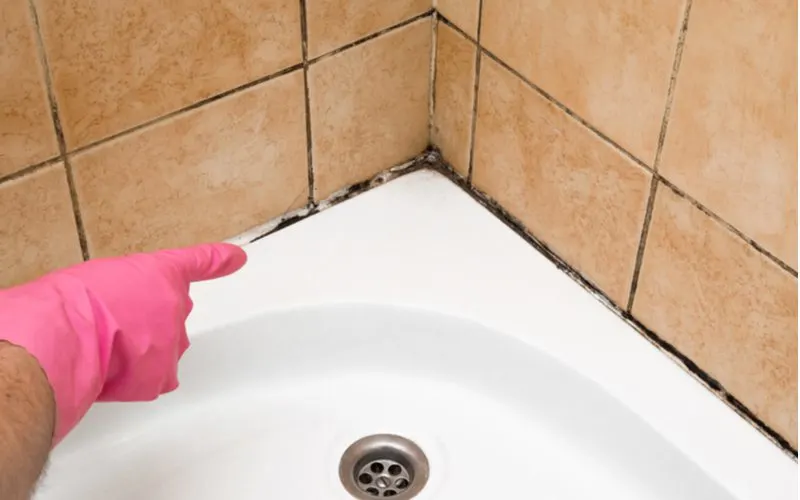
Fotoduets/Shutterstock
While small mold problems can be easy to tackle by yourself, a large or well-established mold infestation can be a challenge to remove using DIY methods.
It can even be dangerous to try and remove mold by yourself, especially if you’re not familiar with proper safety precautions.
Mold spores can cause allergy and asthma symptoms in sensitive individuals, including severe reactions such as shortness of breath and anaphylaxis. When cleaning mold, it’s easy to kick spores up in the air, thereby aerosolizing them.
Without proper respiratory, skin, and eye protection, you may risk giving yourself or others in your home a reaction.
A mold removal professional can get rid of mold growing on your shower caulking without creating an air quality issue for your household.
Hiring an experienced expert also means that you won’t have to handle potentially dangerous chemicals like bleach or ammonia.
If you’re concerned about safely removing mold from your shower caulking, or if your current DIY solutions don’t seem to be working, it may be best to call in a pro.
So, How Do You Fix Mold In Shower Caulk?
Your shower provides the perfect environment for mold spores, which is why mold in shower caulk is a common complaint among homeowners.
Fortunately, there are plenty of DIY solutions that you can try to help you remove any mold that may pose a threat to you and your family.
It may be best to call in a mold removal professional for a safe and effective solution for severe infestations.

